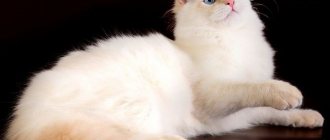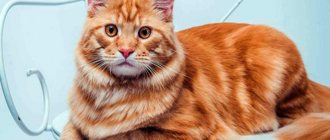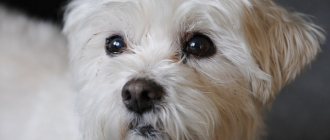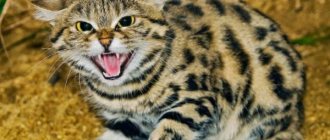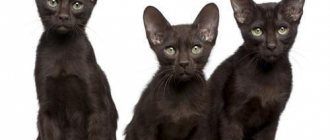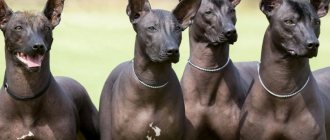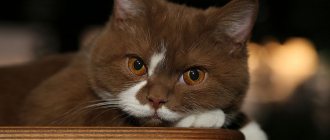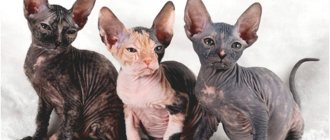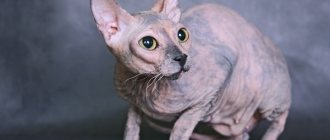Description of cat breeds
There are more than 200 breeds in the world, from completely hairless to long-haired. They are recognized and registered by felinological organizations. 10 of them were selected for this rating, which is divided into calm, beautiful, affectionate, apartment cats.
Let's describe each creation in more detail:
- The Scottish Fold is a fairly old breed that appeared in 1961 in Scotland. The pet is distinguished by its strong build and interesting appearance due to its flattened ears. With proper care, the animal can live up to 16 years.
- Bengal - appeared in the middle of the 20th century and is characterized by an unusual appearance. In terms of color, it can be confused with a leopard, only the Bengal's height is much smaller - up to 32 cm at the withers. The pet's weight is 5-6 kg and varies depending on nutrition.
- Russian Blue - bred thanks to immigrants from Russia. She is striking with her bluish coat, which glistens beautifully in the sun. Her fluff is short and very easy to care for. Life expectancy ranges from 14 to 16 years.
- The Siberian is a Russian cat that appeared around the 16th century. She has medium length fur. She is not cold in winter and at the same time it is easier for the owner to care for the pet. The weight of the animal reaches 6-10 kg, and its height is about 35 cm, depending on its gender.
- The Maine Coon is a creature originally from the USA, up to 40 cm tall at the withers. This is the largest breed in the world and loves space. She lives for about 13 years. She is characterized by a beautiful fluffy tail and tufts on her ears. The pet's character is independent, but calm and balanced.
- Toyger - it is often called the domestic tiger because of the same striped color. The first animal was born in the late 1980s. This breed of kind and affectionate cats is very large - it weighs up to 7.5 kg, so it is a bit heavy to carry in your arms. They have strong paws and massive shoulders.
- The British Longhair is a fluffy creature with thick fur that keeps it warm in the winter. She is distinguished by bright, large eyes and cutely rounded ears. The British are characterized by obedience and unobtrusiveness in relations with their owners.
- The Canadian Sphynx is a relatively small species weighing up to 5 kg. This is one of the longest-living among similar varieties. On average, the Sphynx lives up to 17 years. It does not burden its owner, since it is undemanding in food and care, but it requires certain financial investments to purchase special toys.
- Persian is the most popular and affordable, bred as if specifically for keeping in an apartment. She has declared herself to be a calm and peace-loving animal that bestows affection on its owner and creates comfort in the home.
- The Peterbald is the result of crossing the Don Sphynx and the Oriental breed. It is characterized by the absence of any vegetation. The animal proved to be calm, adequate, friendly and had no problems finding a common language with people, including children.
The best flea drops for cats
Rating of cat breeds
The main guideline when analyzing descriptions of various cat breeds were reviews of their owners and animal care specialists - veterinarians, groomers, etc. An important point was the affordability of kittens.
The analysis was carried out in several directions:
- History of appearance - where and by whom it was bred, with whom it was crossed, when it happened;
- Appearance - color, thickness and length of fur, shape of the muzzle, eye shade, etc.;
- Body build – weight, muscles, height at the withers, massiveness and height of the paws;
- Character – playfulness, obedience, ability to get along with children and other animals, ability to tolerate loneliness;
- Dietary requirements - what kind of food and how often should be fed, tendency to obesity;
- Health – resistance to various diseases, frequency of visits to veterinarians, need for vaccination, life expectancy;
- Features of care - how often it needs to be brushed, whether the hair sheds and falls off, whether the animal tolerates bathing easily and how many times it should be washed.
Very important when preparing the TOP 10 cat breeds was the combination of ease of cat care, undemanding diet, calm and balanced character, beautiful appearance and good health.
The best scratching posts for cats
Neva Masquerade
This is the “sister” of the Siberian cat. They have the same build, thickness and length of fur, and character. But the difference is simply striking - Neva Masquerade cats have color-point colors, which are prohibited in the Siberian standards. During the formation of the Siberian breed, these colors “fell out of favor.” But not all breeders and fans of the new breed were happy with this. Subsequently, some felinological systems introduced color-point colors into the list of permitted colors for Siberians, but enthusiasts have already managed to develop and formulate a standard for the new breed.
The most beautiful cat breeds in the world
Cats with an unusual, bright color, original face and smooth or fluffy fur can be called beautiful. At least 2 breeds meet these selection criteria. This rating category is dedicated to them, where the advantages and disadvantages of the animals in question are described in detail.
Scottish lop-eared
This variety originated in 1961 in Scotland and got its name because of its floppy ears. An adult pet weighs about 4-6 kg and lives for 14-16 years with proper care. It is characterized by a height at the withers of about 30 cm and a short, smooth coat of smoky, red, gray or white color.
The Scottish Fold is the most loyal to other cats and gets along with them without problems even in a small area. She is good-natured and quickly becomes attached to family members, but she chooses one person as her owner and pet. The animal is not indifferent to games and, despite its sociability, prefers not to impose its personality.
Advantages:
- Rarely raises his voice;
- Doesn't scream loudly;
- Accuracy and cleanliness;
- Equilibrium;
- Doesn't damage furniture.
Flaws:
- High cost of kittens.
The Scottish Fold is not burdensome for its owners and can easily tolerate short separations from its owner.
Bengal
The history of the Bengal cat begins in the middle of the 20th century. The animal is distinguished by its gracefulness and bright leopard color. Only it is smaller in size than its older brothers. Height at the withers reaches 25-32 cm with a weight of 5-6 kg. The life of a pet is quite long - 12-15 years, but for this the owner must not forget about regular vaccinations and give him premium food.
The most beautiful cat breed in the world and one of the cleanest. The animal will not go into a dirty tray, so you will have to clean it regularly. She is amenable to training and training, which can begin as early as 3 months after birth. This is a very smart pet, quickly grasping and following the commands of its owners.
Advantages:
- Good health;
- Cats love to mark territory;
- Powerful paws;
- Friendliness;
- Loves water.
Flaws:
- Very playful, so you can’t do without a special complex.
As reviews show, Bengals get along well with other animals, except rodents, which they happily hunt.
Breeds of kind and affectionate cats
Cats are rather proud and solitary animals, less attached to humans than dogs. However, in general, by their nature they are rather kind and affectionate; there are only a few aggressive varieties among them. VyborExpert specialists studied descriptions of the kindest and most affectionate pets. As a result, 2 options with an easy-going character were included in the rating.
Russian blue
The Russian Blue received its name due to its breeding on the basis of ancestors from Russia and due to the bluish tint of its coat. Her fur is not thick and short, so it does not create any problems with care. It is enough to comb the animal 1-2 times a week. The pet is quite large - weighing up to 3-7 kg. Height at the withers reaches 25 cm. On average, she lives 14-16 years.
The Russian Blue has long, muscular legs and sharp fangs, with which it easily catches rodents. It has good endurance and high speed, running away from other animals without any problems. A thin but dense coat reliably protects it from frost and rain. Due to the short length of the coat, this is a good option for allergy sufferers.
Advantages:
- Laskova;
- Flexible;
- Has a sense of tact;
- Curious;
- Playful.
Flaws:
- Regular cleaning of the tray is required;
- You need to constantly monitor the cleanliness of the bowl.
Speaking about which cat breed is better, the Russian Blue cannot be ignored because of its disgust and cleanliness, so it is suitable for exactly the same owners.
Siberian
The breed is of Russian origin, developed around the 16th century. She is a semi-long-haired breed, so she is easy to care for. The cats are quite large, weighing 6-10 kg. Their height at the withers reaches 30 cm in girls and 40 cm in boys. The animal lives the longest of all varieties - 15-20 years. The pet acts as a territory guard and fiercely defends its territorial rights.
The Siberian cat is characterized by intelligence and special intelligence. The animal has a well-developed hunting instinct and happily catches rodents and birds. The pet gets along easily with household members, but has an independent and proud character. She doesn't like strangers and loud voices, she needs comfort and tranquility.
Advantages:
- Gets along well with children;
- Likes to play;
- Sheds heavily;
- It is enough to bathe once every 3 months;
- You can feed it natural food.
Flaws:
- Does not get along well with other animals;
- Requires frequent walks in the fresh air.
Siberian representatives, due to their developed intelligence, are easy to learn and train. They get accustomed to the tray and scratching post without any problems.
Maine Coon
The Maine Coon is the largest cat breed. They can reach up to 15 kg in weight. They have a large, muscular body with large paws. The eyes are round and always close-set. The coat is silky, in several layers. A distinctive feature of Maine Coons is their ear tufts, like those of a lynx.
Balanced character, very sociable and calm. They do not show aggression or distrust towards strangers. They get along well with other pets and can be friends with them. They show an interest in water and love to wet their paws in their water bowl and then lick the water off them. They will never beg for food from the master's table or steal it furtively.
They need to be brushed once every week or two, otherwise large tangles may form on the fur.
The best cat breeds for children
If there are children in the house, it is better to give preference to calm, but at the same time playful cats that do not mind spending time with the child. These include one species originally from America, which has distinguished itself by having the best relationships with young household members.
Maine Coon
The cat was bred in the USA. The animal grows up to 30-40 cm at the withers and up to 1 m in length. Due to its large size, it is not recommended to keep it in an apartment. The pet's weight ranges between 4-10 kg. The average lifespan of a Maine Coon is 13 years, with centenarians 15 years. It has specific tufts on its ears, which resembles a lynx, and a huge fluffy tail, like a raccoon. In appearance it looks more like a wild one.
When trying to figure out which breed of cat is best for children, it should be noted that this is an intelligent and independent creature, with a calm, balanced character. She may not trust adults and not allow herself to be petted, but she treats children with special reverence and enjoys playing with them. The Maine Coon is highly trainable, like a dog, thanks to its good memory, understanding and ability to recognize intonations in the owner’s voice.
Advantages:
- Loves water and swimming;
- The wool does not roll into tangles;
- Brushing once a week is enough;
- Good at catching rodents;
- Hunts fish.
Flaws:
- Actively sharpens nails on furniture.
The Maine Coon cannot be called a domestic cat; he is more of a loner who loves to walk on the street by himself.
TOP 10 most affectionate and playful cats
Cat owners know very well how interesting it is to watch when a pet is hunting for an imaginary mouse or simply running around the house. Some cat breeds can maintain their lively personalities not only as kittens, but also as adults. Let's look at which breeds are the funniest and most playful:
• 10 • Japanese Bobtail
These pets devotedly love their family and are ready to spend all their time entertaining their owners. Very active and playful - the Japanese Bobtail immediately begins to run and jump at the sight of its favorite toy. It’s interesting to watch their funny games, however, bobtails love their owners not to “look at them with a smile while sitting in a chair,” but to play with them.
more details
• 9 • sphinx
Very smart and always energetic, unconventional in appearance, sphinxes are always ready to have fun with their owners and guests. They have excellent control over their bare paws with elongated fingers - they quickly grab small objects with them.
more details
• 8 • oriental cat
Those owners who love cats that are energetic, always sociable and ready to communicate will find in the Oriental cat an excellent friend, always ready to actively play and cheer up its owner. Moreover, even the passing years do not particularly reduce their enthusiasm and “endless” energy.
more details
• 7 • munchkin
These little cute creatures with small paws, it seems, are simply “not capable of growing old.” And indeed, they can maintain a playful, cheerful, friendly character even in the most advanced cat age.
more details
• 6 • Somali cat
Beautiful in appearance, Somali cats love active attention. Your pet will sit near the door for hours, waiting for you to come home and start playing with it. The extremely high degree of “overflowing energy” does not subside over the years.
more details
• 5 • ocicat
The real blood of wild ancestors flows in the veins of the Ocicat, so this cat is simply a “perpetual motion machine.” The sociable animal is in constant search of prey or playmates. She is not at all afraid of new guests, and boldly invites them to have fun.
more details
• 4 • Siamese cat
In fact, known for their penchant for hunting sparrows, Siamese cats are very playful. True, they are ready to have fun with their owners - only if they themselves want it.
more details
• 3 • Cornish Rex
If you dream of an energetic, inquisitive and lively cat, then this is just the Cornish Rex. For such a cheerful creature: everything in life is a game (they never get tired, climb everywhere with virtuosity, jump actively, and at the same time have very agile legs).
more details
• 2 • bengal cat
The Bengal cat learns relatively quickly and masters a huge number of tricks at a young age - she loves all kinds of games. The fun of these smartest funny guys includes: turning on or off the light, opening the door on their own or flushing the toilet...
more details
• 1 • Abyssinian cat
The Abyssinian cat rightfully occupies the first place in our rating: she is ready to run after a mouse all day, she has a cheerful character - it’s never boring with this pet. The Abyssinian cat is always “hyperactive” and never gets tired - if a butterfly flies into the room, it will rush after the insect until it catches it (even if this takes several hours).
more details
Expensive cat breeds
Expensive ones include mainly exotic breeds that were bred far abroad and are in limited access. Their price can exceed 20,000 rubles. One of these is considered to be Toyger, which will be discussed further.
Toyger
A breed of domestic "tigers", only smaller in size. It was because of its specific appearance that it received its name: Toy (toy) + tiger (tiger). This is a fairly young animal, appearing in the late 1980s. Toyger is one of the largest cats weighing up to 7.5 kg. They are characterized by massive shoulders and paws, thanks to which they can develop high speed.
The toyger has short hair, so it does not tolerate cold winters very well. But because of this, it is convenient to bathe him and treat him for parasites. The breed is capable of learning games and house rules. She is smart and gets along easily with children, adults and other animals. The pet is docile and calm, never raises its voice without a pressing reason, but often purrs loudly and contentedly while lying on the owner’s lap.
Advantages:
- No need to comb every day;
- It is enough to feed 2-3 times a day;
- Easy to train to the tray;
- Good memory;
- Rarely gets sick.
Flaws:
- Worse returns home in his footsteps.
The Toyger is one of the most expensive cat breeds in the world and is not recommended to be fed fish. Due to this diet, she may experience indigestion.
Bengal cat
This breed was created artificially by crossing wild and domestic cats. They always attract attention because of their unusual color, similar to that of a leopard. They seem aggressive at first glance, but are actually very affectionate and kind. But these cats need to be handled and educated while still kittens, otherwise they can turn into a wild, uncontrollable cat.
They are very active and playful until old age. Because of this, they can become a common cause of clutter in the house. Unlike other breeds, Bengal cats show a great interest in water, are not afraid of it, can play with water and love to swim.
This is interesting - the most famous cat breeds, TOP-8.
Popular cat breeds
Many people fell in love with both long- and medium- and short-haired animals. Pets with an original appearance and easy contact with people are popular. This is how we can characterize the following 2 varieties, which are widely known in the world.
British Longhair
A cat with long fluffy and thick hair that requires special care. The animal weighs about 7 kg, has large bones, full cheeks and a rounded muzzle. The pet has large, expressive eyes and slightly rounded erect ears. There are gray, white, red, black colors, multi-colored ones are rare.
The British Longhair is known for its calm temperament, which is why it is often chosen as a companion for children. The animal's character is sociable, but not intrusive. In terms of its behavior, this is an aristocratic cat. This breed quickly becomes attached to people, but tolerates loneliness without any problems.
Advantages:
- Cleanliness;
- Does not tear wallpaper or scratch upholstered furniture;
- Restraint in behavior;
- Trainable;
- Not cunning and not vindictive.
Flaws:
- Tendency to corpulence.
Due to the risk of gaining excess weight, veterinarians recommend maintaining a balanced diet and feeding your pet with special food. With proper care, the animal can live up to 14-16 years.
Canadian Sphynx
The Sphynx breed is considered domestic and is popular because of its obedience to its owner. She is not at all suitable for walking on the street, especially without human supervision. The animal has no hair, is completely bald, 30-40 cm tall and weighs from 3 to 5 kg. Among them there are many centenarians aged 17 years. The cat is very calm and does not require unnecessary attention, but it is important to limit its exposure to the sun. She has no fur and therefore can get burned.
The Canadian Sphynx is considered the most popular cat breed, in particular, because of its love for people's attention and various toys. Therefore, you will have to buy special things for him - a house, a scratching post, etc. But if he is away from home for a long time, he will be able to organize his own pastime. The pet gets along well with its own kind and even with dogs. He is characterized by a good appetite, so he needs to be fed with expensive, carefully balanced ingredients. It is important to monitor the caloric content of the diet due to the tendency to be overweight.
Advantages:
- Fast metabolism;
- Rarely gets sick;
- Easily tolerates travel;
- Does not suffer from short-term separations from owners;
- Unusual, “alien” appearance.
Flaws:
- May cause allergies in humans;
- Needs regular care.
The Canadian Sphynx often participates in exhibitions and takes prizes thanks to its expressive eyes, cute elongated muzzle and large ears.
The most popular cat breeds in the world. Team rating
Contents hide
The most popular cat breeds in the world. Team rating
It's been a while since we spoiled you with all sorts of ratings, dear readers! The reasons for this are the most objective: the results of 2017 have been summed up, and this year is still in full swing. But our American colleagues from thespruce.com portal cannot sit still! And they decided to offer us their own rating. No, they did not conduct any survey among their readers. Everything looked different. How exactly? Read the article and find out.
How many cat breeds are there in the world, do you think? Fifty, one hundred, two hundred? Another question. Do you know who exactly has the right to consider some animals purebred and who not? Can you name at least one large international felinological organization? We are afraid that our questions have puzzled you. Well, first things first.
First of all, about the three largest and most authoritative international felinological organizations. The same ones that keep breed registries. First on our list is the Cat Fanciers Association (international abbreviation CFA). Its registries include 44 cat breeds. The second is the International Cat Federation (FIFe). There are 43 breeds in its registries. And the third, it is also unofficially the most “democratic” - the International Cat Association (TICA). TICA's portfolio includes 58 breeds. As you can see, each felinological organization has its own approaches and criteria - which cats are considered purebred and which are not. Therefore, some breeds are considered "partially recognized".
Of course, we have provided a far from exhaustive list of felinological organizations. Why? Everything is explained simply: our colleagues from thespruce.com, when compiling their rating, operated on data from only the three above-mentioned associations and federations. It should be emphasized that each such organization issues its own ratings. But our colleagues decided to put one on top of the other and see what happens. The result in front of you is a certain “composite”, “combined” or “general” rating. We think the work turned out to be interesting. And we all, of course, can’t wait to find out what the world of cat lovers is doing!
First place. Siamese cat. The breed has been steadily popular since the end of the 19th century, when the first “Siamese” were brought to the Old World. Note that today's Siamese cats have come a long way from their ancestors. And the breed standards have also been rewritten several times. One thing we know for sure: Siamese cats are still recognizable and much loved. With which we sincerely congratulate them!
Second place. Persian cat. And who doesn’t know the wonderful phlegmatic “peaches”? The popularity of the breed seems to be eternal, everlasting. Admirers are not afraid even of the difficulties in caring for a long coat. Everyone's favorites - well noted!
Third place. Maine Coon. Or, as he is also called, the “gentle giant.” The largest breed of domestic cats on the planet, by the way! Maine natives, true Americans!
Fourth place. Ragdoll. Who wants a soft, fluffy and pliable rag doll? Please – we have a ragdoll for you. If you like hugs and kisses, then this is the place for you!
Fifth place. Bengal cat. The breed is a hybrid – it has some of the blood of the wild Asian leopard cat flowing in it. Hence the unofficial nickname of the “Bengalis” - indoor leopards. Want a piece of the jungle at home? Then splurge!
Sixth place. Abyssinian cat. It feels as if the graceful Abyssinians just came out to us yesterday from the sands of the African deserts! “Abyssinians” are rapidly gaining popularity here in Russia. Keep it up!
Seventh place. Burmese cat. Variation on the “colorpoint” theme. Do you want to distinguish yourself by taking a “Siamese” in the “light” version? Choose the Burmese - they are more accommodating!
Eighth place. Oriental cat. Do you like the occult and watch the stories of the Ren-TV channel? Get an Oriental - you will have something to say to each other!
Ninth place. Sphinx. Tender, affectionate, velvety, truly domestic cats. Take the sphinx - you will love him very much, really!
Tenth place. Devon Rex. He may seem irritated to you. Or surprised by something. But he is kind, affectionate and incredibly affectionate. Rex is forever!
Eleventh place. Himalayan cat. Just some kind of celebration on the street for colorpoint lovers! Why not consider the Himalayan? Both Siamese and Persian cats “participated” in the creation of the breed. The result is impressive. You just can’t take your eyes off it!
Twelfth place. American shorthair cat. A favorite of the Yankees, neither give nor take. No wonder it is considered almost a national symbol!
This is the rating from our colleagues from the United States. Do you consider it objective, dear readers? Even if not, don't worry! All the same, despite any ratings, you know that your pet is the most expensive, the best. Is it true?
Photo: pixabay.com. An Abyssinian cat is depicted.
Calm cat breeds for apartments
Calm cats are those that do not meow much, do not damage furniture, and tolerate temporary separation from their owner without any problems. Among these breeds, two varieties should be especially highlighted, the advantages and disadvantages of which are described below.
Persian
This variety is famous for its long hair. The pet is completely domesticated, it is difficult for him to live outside the apartment. It is distinguished by a balanced character and lack of aggression; the animal quickly becomes attached to its owner and ignores those it does not like. With her calmness, she can stand up for herself. This is a calm breed of cat for an apartment; neighbors will not complain to the owners because of the constant meowing.
Persians respond appropriately to children, but are not their best companions. They lead a fairly active lifestyle and love to play with people. However, these are not predators and you can hardly expect them to hunt mice. This breed is one of the most curious; it likes to explore corners of the house and hide from its owners. It is not easy to care for - the coat requires daily combing to avoid matting, and bathing a pet is a test of nerves.
Advantages:
- Lives up to 17 years;
- It comes in different colors - from white to black;
- Beautiful appearance;
- Flexible;
- Not picky about food, but needs to be fed special food.
Flaws:
- The sun changes the coat color;
- Does not like to sleep with owners;
- Grows weighing up to 7 kg.
Persians have a nasal septum defect due to their flattened nose, causing the animal to snore and sniffle. It also causes the eyes to constantly leak fluid, requiring them to be washed regularly.
Peterbald
The breed was obtained by crossing an Oriental cat and a Don Sphynx. Its characteristic difference is the absence of hair (or a small undercoat), mustache and eyebrows. Despite this, the animal is not hypoallergenic; an attack can be caused by its saliva. Although the pet has an aggressive appearance, it is docile and friendly, gets along easily with people and makes contact.
Peterbald is characterized by a hunting instinct; he catches rodents and birds. The animal is strongly attached to people, so leaving it alone in the apartment for a long time is not recommended. The pet loves to sleep on the same bed with its owner. This breed reaches a length of 23-30 cm and weighs about 3-5 kg, which is why it is easy to transport. Its life expectancy is 13-15 years under good living conditions.
Advantages:
- Forgiving;
- Quickly learns to use the toilet;
- Smart;
- Moderately active;
- Gets along easily with other animals.
Flaws:
- Meows loudly until he gets his way;
- Sweats quickly and requires frequent bathing;
- Discharge accumulates in the eyes, which must be removed periodically;
- Does not tolerate drafts due to lack of wool;
- Needs to be fed more than other varieties.
It is better not to leave this breed of cat alone for a long time - she is curious and a real sneak: she explores cabinets, drawers, and furniture in the house, so she can make a slight mess and accidentally ruin things.
What breed of cat is suitable for an apartment?
In city conditions, it is difficult to provide a cat with walks in the fresh air. When choosing a cat for living in the city, it is better to give preference to calm breeds that can easily tolerate life in an apartment.
British Shorthair
This breed adapts well to apartment life. British Shorthair cats can easily tolerate long absences from their owners. They get along with children, but do not like it when their personal boundaries are violated. Calm and aristocratic, they will feel good in an apartment.
Russian blue
Russian Blues are reserved cats with a gentle but independent character. Despite this, they love outdoor games. Therefore, it is good to have a cat tree at home that your Russian Blue can climb. Cats of this breed are very clean.
Ragdoll
Ragdoll cats are calm and kind. This breed gets along well with children. Despite their long hair, Ragdolls are easy to care for: it is enough to brush them once a week, and during the shedding period - twice a week. The Ragdoll is not suitable for those who are not home much, because this breed needs the attention of the owner.
Burmese cat
The Burmese cat is suitable for those whose home is quiet and calm. Cats of this breed do not like noise and harsh sounds. They have a calm character. Burmese cats become attached to their owners, but do not mind being alone. Burmese are very sensitive to cold and drafts, so they feel good in the apartment, provided that it is warm and there is no draft from the windows.
Persian cat
Persians have a reserved character. They prefer to lie quietly next to their owner to active games. Persian cats don't talk much. These cats were bred specifically for indoors, so they do well in an apartment. True, you will have to pay special attention to caring for the hair of a Persian cat. Experts recommend brushing them daily.
Which cat breed is better
When choosing a cat, it is best to focus on the conditions under which it is kept. If you need a hunter, then you need to pay attention to playful, active pets who will happily catch rodents. Those who are looking for a companion for children and a keeper of home comfort should take a closer look at calmer breeds.
At the end of the rating, the editors of the Vyborexperta.ru magazine summed up the results:
- If you need a beautiful and obedient creature, then the Scottish Fold will come in handy.
- Those who prefer more “wild” animals should pay attention to the Bengal breed.
- If you have allergies in your household, you can choose a Russian Blue with short hair.
- Look for a rodent catcher - it is recommended to choose a Siberian cat with a good hunting instinct.
- A Maine Coon with a calm and balanced character will be a good companion for children.
- If you want something exotic, then a Toyger with an unusual color will be just right.
- Among the aristocratic varieties, the British Longhair deserves special mention.
- The Canadian Sphynx, Persian and Peterbald are the best suited for keeping in an apartment.
To choose any breed of cat, you need to take into account many nuances - where the animal is kept, your financial status and the ability to allocate enough time to care for your pet. This is the only way this cute creature will become a full-fledged member of the family.
